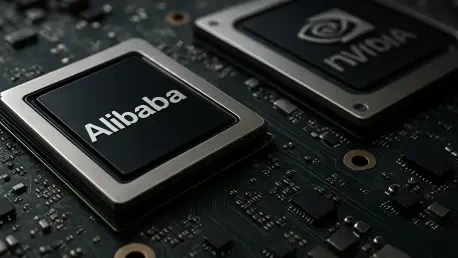In a world where artificial intelligence is reshaping industries at breakneck speed, a surprising contender has emerged to challenge the reigning champion of AI hardware. Alibaba, the Chinese tech giant best known for e-commerce and cloud computing, is stepping into the high-stakes ring of semiconductor innovation with a new AI chip designed to rival Nvidia’s dominance. This isn’t just a corporate pivot—it’s a seismic shift driven by necessity, ambition, and global tensions. What fuels this audacious move, and can Alibaba truly disrupt a market long ruled by an American titan?
Why Alibaba Is Taking on Nvidia in the AI Race
The battle for AI supremacy is no longer confined to software algorithms or data centers; it’s now deeply embedded in the silicon chips that power these technologies. Alibaba’s decision to develop its own AI inference chip marks a strategic leap into a domain where Nvidia has held an iron grip, commanding over 80% of the global AI chip market. This bold step isn’t merely about technological prowess—it’s a response to a pressing need for independence in a landscape where access to cutting-edge hardware is increasingly uncertain for Chinese firms.
At the heart of this move lies a determination to redefine Alibaba’s role in the tech ecosystem. While the company has long been a powerhouse in online retail and cloud services, entering the semiconductor space signals an intent to control its own destiny in AI-driven innovation. This shift positions Alibaba not just as a consumer of technology but as a creator, aiming to reduce reliance on foreign suppliers amid growing barriers.
Geopolitical Tensions Fueling the Push for Self-Reliance
The backdrop to Alibaba’s chip development is a complex web of international restrictions and national priorities. Since tightened US export controls began impacting Chinese access to advanced semiconductors, companies like Alibaba have faced significant hurdles in securing even modified versions of Nvidia’s GPUs, such as the H800 or ##0. These restrictions, coupled with concerns over data security and potential vulnerabilities in foreign tech, have accelerated China’s drive toward a self-sufficient tech ecosystem.
For Alibaba, crafting a homegrown AI chip is more than a business strategy; it’s a critical step to ensure stability in its cloud computing operations, which are central to its growth. Aligning with national goals to keep sensitive data within borders, this initiative reflects a broader movement among Chinese tech giants to build resilience against external disruptions. The stakes are high, as failure to innovate could mean falling behind in a global race where AI is the ultimate currency.
Unpacking Alibaba’s AI Chip Strategy and Competitive Edge
Delving into the specifics, Alibaba’s new 7nm AI inference chip, currently under testing, reveals a calculated approach to challenge Nvidia’s mid-tier offerings. Unlike its earlier Hanguang 800 chip, which lagged 40–60% behind Nvidia in performance, this latest iteration targets versatile inference workloads—think powering recommendation engines or natural language processing. By focusing on these practical applications, Alibaba aims to carve out a niche against Nvidia’s China-compliant GPUs like the ##0.
A key pillar of this strategy is the shift to domestic manufacturing, leveraging China’s Semiconductor Manufacturing International Corporation (SMIC) instead of relying on Taiwan’s TSMC. Despite SMIC’s crowded 7nm capacity, shared with competitors like Huawei, this move underscores a commitment to localized production. Additionally, compatibility with Nvidia’s CUDA and PyTorch ecosystems offers a significant advantage, easing the transition for developers accustomed to Nvidia’s tools and bypassing the fragmented software environments of other domestic rivals.
Expert Perspectives on Alibaba’s Potential to Disrupt Nvidia
Industry analysts provide a nuanced view of Alibaba’s ambitions in the AI chip market. Pareek Jain, CEO of EIIRTrend & Pareekh Consulting, highlights that the chip’s focus on broader workloads positions it as a direct competitor to Nvidia’s less advanced offerings, though it falls short of matching flagship products like the #00. This gap in raw performance remains a hurdle, but the strategic targeting of specific use cases could still win market share.
Neil Shah from Counterpoint Research emphasizes the importance of software integration, noting that Nvidia’s dominance owes much to its robust CUDA platform. Alibaba’s compatibility with this ecosystem could be a game-changer, lowering barriers for developers frustrated by supply constraints of Nvidia chips in China. Meanwhile, Alibaba Chairman Joe Tsai, as referenced by Danish Faruqui of Fab Economics, ties the chip’s development to sustainable growth in AI cloud services, underscoring its role in navigating export uncertainties. These insights collectively suggest a mix of opportunity and challenge ahead.
Strategic Steps for Alibaba to Gain Ground in the AI Chip Market
To transform this chip into a credible rival, Alibaba must adopt a multifaceted approach tailored to its unique position. Optimizing system-level design, similar to Huawei’s innovative Cloud Matrix 384, could offset hardware limitations by enhancing overall efficiency. Such integration would maximize performance in real-world applications, making the chip more appealing to potential users.
Another critical focus should be on developer adoption by doubling down on CUDA and PyTorch support with comprehensive resources like tutorials and migration tools. Expanding the chip’s deployment through Alibaba Cloud, starting with in-house data centers and extending to regions like Southeast Asia and the Middle East, could establish it as a localized alternative to global giants like AWS. Finally, using this development as leverage in negotiations with Nvidia for better supply terms could capitalize on current market shortages, strengthening Alibaba’s bargaining power in a constrained landscape.
Reflecting on Alibaba’s Journey and the Road Ahead
Looking back, Alibaba’s venture into AI chip development stood as a testament to adaptability in the face of daunting geopolitical and technological barriers. The push to create a 7nm inference chip marked a pivotal moment, reflecting both corporate ambition and a national imperative for self-reliance. Despite the performance gaps compared to Nvidia’s top-tier hardware, the emphasis on software compatibility and strategic workloads showcased a pragmatic path to relevance.
Moving forward, the focus shifts to actionable progress—refining system designs, fostering developer ecosystems, and scaling cloud integration become essential next steps. Beyond Alibaba, the broader implications for China’s tech landscape hint at a future where domestic innovation could reshape global AI dynamics. The journey is far from over, but the groundwork laid offers a compelling glimpse into how resilience and strategy could challenge even the most entrenched players.









